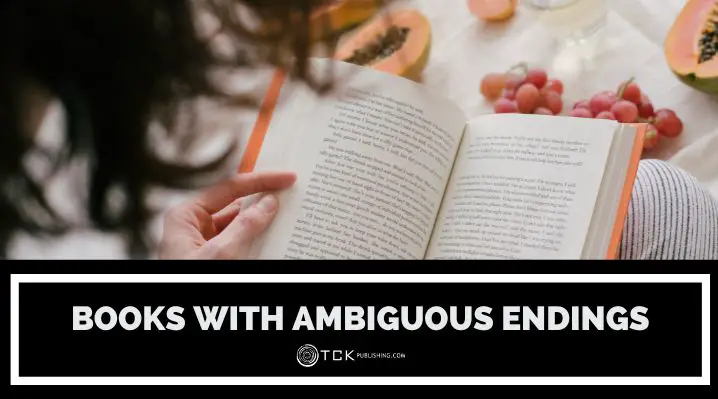
Some books tie everything up in a neat bow. Others leave you with more questions than answers. That’s the point!
Ambiguous endings can be frustrating, sure, but they’re also powerful. Possibilities simmer in your mind long after the last page.
And if you enjoy books that leave space for your thoughts, you’ll want to check out these ones below.
What Is an Ambiguous Ending?
An ambiguous ending leaves the story open. Instead of closing the plot, it offers different ways the story could go.
Think of it like this: a clear ending takes you straight to the finish line. An ambiguous one gets you close, then leaves you at a fork in the road. Now it’s up to you to choose which path the story takes.
It can feel odd at first. You’re the one deciding how it ends. But that’s the point. The author wants you to pause, think, and choose the resolution that matters most to you.
Ambiguous endings can be hit or miss. Some people think they’re cheap. Others appreciate the thinking space the author gives them.
Books With Ambiguous Endings
Below is a list of books with ambiguous endings that make people pause, wonder, and debate what happens next.
The Giver by Lois Lowry
Jonas escapes the strict world he knew, carrying a baby, toward a snowy hill. Near death and cold, he finds a house with warm lights. Is it real or a hallucination?
Their fates are confirmed in two sequels. But considering those novels were released a decade later, the original ending stood alone for years. It matched the story’s deeper themes of hope, freedom, and the price of choice.
Life of Pi by Yann Martel
Pi Patel is shipwrecked and stranded on a lifeboat for 227 days. His account, which includes a Bengal tiger named Richard Parker, raises doubts about what really happened. And so Pi tells a second, much darker story involving other survivors and no animals.
In the end, investigators (and the audience) must choose: believe the version filled with wonder, or the one that’s harsher but more human.
Picnic at Hanging Rock by Joan Lindsay
In 1900, a group of schoolgirls go on a picnic to Hanging Rock. Several of them wander off and mysteriously vanish. Some are found, some aren’t. No clear explanation is ever given, and the mystery is never solved.
This one’s another special case. Joan Lindsay originally wrote a final chapter that explained the mystery, but her editor, Sandra Forbes, convinced her to leave it out. It was published after Lindsay’s death, solving the mystery.
Blood Meridian by Cormac McCarthy
The Kid joins a gang of scalp hunters in the American Southwest. He meets Judge Holden, a brutal man who may or may not be supernatural.
Years later, the Kid, now the Man, is confronted by Holden in an outhouse. The Judge shuts the door behind them. Later, two men open it and stare inside in horror. The Judge dances. He says he’ll never die.
Things are never explained. The epilogue is quite baffling, too.
The Guest Cat by Takashi Hiraide
A married couple lives a quiet life in a small Tokyo home. Their days are set, their conversations familiar. Then a cat comes along, bringing joy and transformation to their daily life.
Things shift when the cat stops coming. Their home is sold, and their peaceful life unravels. The cat and the couple’s fate are unclear.
You Don’t Know Me by Imran Mahmood
An unnamed defendant stands accused of murder. Right before closing speeches, he abruptly fires his lawyer. He addresses the jury, going through all eight key pieces of evidence against him.
The book essentially ends when his statement ends. You, the jury, must now determine if he is guilty.
Head Full of Ghosts by Paul Tremblay
Fifteen years after a teenage girl’s apparent possession, her younger sister shares the story in a tell-all interview. Was it mental illness? Demonic possession? A desperate family’s breakdown?
The ending doesn’t tell you what to believe. All you can do is sort through the lies, trauma, and horror to figure it out.
My Cousin Rachel by Daphne du Maurier
Philip’s beloved cousin Ambrose dies under mysterious circumstances. Suspicion falls on his widow, Rachel. Determined to uncover the truth, Philip invites her to England. He falls in love.
Did Rachel poison Ambrose? Is she planning to harm Philip next? Or is she wrongly accused?
The novel ends with no clear answers. Rachel dies, and Philip is left with doubt, guilt, and no proof of anything.
The Handmaid’s Tale by Margaret Atwood
Offred lives under the strict, theocratic rule of Gilead, where women have lost almost all rights. As a Handmaid, her only value is reproduction. The novel follows her early days of obedience to her eventual rebellion.
In the end, Offred is taken away—possibly by rebels, possibly by the regime. The novel closes with a note from the future. Academics have found her tapes, but never discovered what happened to her.
Arch of Triumph by Erich Maria Remarque
Ravic is a German refugee and surgeon, living without papers in Paris. He is haunted by war and loss, but finds hope and a fragile love in Joan, an actress.
Tragedy strikes in the final pages, and Ravic faces deportation again. However, Remarque leaves his fate unknown.
Why An Ambiguous Ending?
Not all stories need neat conclusions. Some even demand open ends to stay honest to their themes. Life doesn’t always tie up cleanly, and neither do the best stories.
Ambiguous endings stick with you. They make you re-read passages, discuss theories with friends, and think about the story in deeper ways. That’s what makes them unforgettable.
It can be frustrating, but also powerful. You become part of the creative process. You fill in the blanks. In doing so, you arrive at an ending that is personal.
What’s your favorite ambiguous ending? Share your thoughts below!
If you enjoyed this post, then you might also like:
- 11 Fascinating Books with Dual Timelines
- 10 Recommended Books with Love Triangles
- 12 Intriguing Books About Family Secrets
- 12 Books about Parties That Go Incredibly Wrong

Cole is a blog writer and aspiring novelist. He has a degree in Communications and is an advocate of media and information literacy and responsible media practices. Aside from his interest in technology, crafts, and food, he’s also your typical science fiction and fantasy junkie, spending most of his free time reading through an ever-growing to-be-read list. It’s either that or procrastinating over actually writing his book. Wish him luck!
